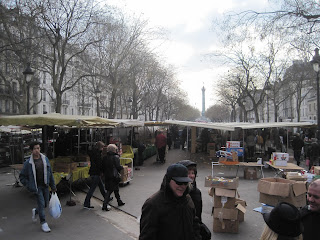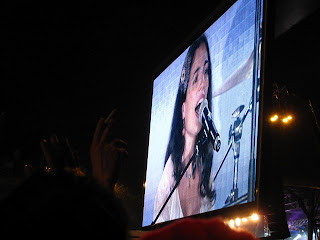Voila! Though not be the most refreshing dessert summertime weather, my boyfriend had never heard of the infamous American classic, Bread Pudding, so I had to whip up a recipe, during the hottest week of May in Paris, of course.
 |
| With a side of salted butter caramel ice cream of courese |
I will confess, this is not my recipe. Rather it is adapted from Diana Rossen Worthington's bread pudding recipe, found in her extremely useful book "Seriously Simple: Easy Recipes for Creative Cooks". I highly recommend the book for the newbie cooks out there.
 |
| Can't keep them apart |
 |
| My dates for the night (teeheehee) |
Below is the recipe, enjoy! And try not to eat it before it is cooked, however tempting sugary egg soaked brioche may be....mmmm...gooeyness....
Ingredients
- Your face
- 1 pound of day old Challah bread or Brioche bread (something with similar consistency), cut into 1-2 inch cubes. (I just used brioche from the supermarket, took it out of its bag for a day, then cut it up)
- 3 bananas, sliced
- 6 or more tablespoons of speculooos (enough to coat the slices of banana, but not so much that you cannot see the bananas. This is really a personal preference of speculoos lovers out there)
- 6 eggs
- 2 egg yolks
- 1.25 cups of granulated regular sugar
- 3.5 cups half and half (for my European cookers, you can mix equal parts heavy whipping cream, called Creme Fleurette in France, with equal parts whole milk to come up with half and half. Thank you, David Lebovitz)
- The company of a fat cat
- 1 tablespoon vanilla extract
- Pinch of nutmeg
- An empty stomach
 1) Cut up brioche and place in bowl
1) Cut up brioche and place in bowl2) Butter a 9 by 13 baking dish
3) Place speculoos in a small microwaveable bowl and microwave on high for a minute, covered, checking at 30 second intervals. You want the speculoos to be gooey and melty, but not hard from overheating.
4) Once hot and melty, add bananas to the bowl and mix around. If it looks like there is too much speculoos, add some more bananas or take out speculoos. If not enough speculoos, microwave some more and add it to the bowl.
5) Add banana speculoos concoction to bowl of brioche and mix around, evenly coated.
6) Pour bread mixture into baking dish evenly.
 |
| This one has banana speculoos on the left and dates on the right. Experimenting to see which would be yummier. |
7) Combine the eggs and egg yolks in another bowl, medium sized bowl. Beat with an electric mixer until frothy, or with a whisk until frothy, which is around five to seven minutes.
8) Add the sugar and continue beating until it becomes thick and lighter colored, about ten minutes if by hand, three minutes by electric mixer.
9) Turn off the machine, add the half and half, and mix just to combine, not to beat (woohoo! no more whisking!)
10) Pour creamy delicious solution evenly on top of bread. Let sit for a half hour to an hour, occasionally pushing the bread down with a spoon to allow the liquid to rise and really soak into the bread.
 |
| Mmmm gooey bread |
11) Preheat oven to 375 F (190 for celsius users) and stick the bread pudding in the oven. Cook for 20-25 minutes, take out, push bread down to let custard rise again and move the custard around so evenly distributed, then place back in the oven for another 15-20 minutes, or until a knife inserted in the center comes out clean. I like my pudding on the gooey side, so I go for less time, but it is a personal preference.
12) Finishing touches: once out of the oven, let it sit for 10 minutes to cool down. Serve on its own, with ice cream, or a creme anglaise sauce (sweet liquid whipped cream sauce). To me, banana speculoos calls for vanilla or caramel ice cream, or both! Be creative. Add pecans or walnuts for a true banana bread experience...enjoy!
 |
| Already eat for dessert before being apple to capture it...and the banana side won. |
Also: this dish is great cold, and a wonderful snack in the morning with milky black tea. Like lasagna, it gets better with each day, as more of the flavors soak into the starch.



















































